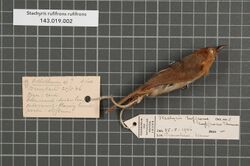Biology:Rufous-fronted babbler
| Rufous-fronted babbler | |
|---|---|

| |
| From Mehao Wildlife Sanctuary, Arunachal Pradesh, India | |
| Scientific classification | |
| Domain: | Eukaryota |
| Kingdom: | Animalia |
| Phylum: | Chordata |
| Class: | Aves |
| Order: | Passeriformes |
| Family: | Timaliidae |
| Genus: | Cyanoderma |
| Species: | C. rufifrons
|
| Binomial name | |
| Cyanoderma rufifrons (Hume, 1873)
| |
| Synonyms | |
|
C. ambigua (Harington, 1914) | |
The rufous-fronted babbler (Cyanoderma rufifrons) is a babbler species in the Old World babbler family. It occurs from the Eastern Himalayan foothills to Southeast Asia at altitudes of 120–2,100 m (390–6,890 ft).[1]
It is buff-brown with paler brown underparts and a dull rufous crown. Its upper wings, tail, supercilium and lores are whitish-grey. It is 12 cm (4.7 in) long and weighs 9–12 g (0.32–0.42 oz). Its song is a high-pitched tuh tuh-tuh-tuh-tuh-tuh.[2]
Stachyris rufifrons was the scientific name proposed by Allan Octavian Hume in 1873 who described a small babbler from the Pegu Range in Myanmar that was pale brown, had a rufous-coloured head and white lores.[3] Stachyrhidopsis rufifrons ambigua was proposed as a subspecies by Herbert Hasting Harington in 1914 for a rufous-fronted babbler with yellow lores, probably occurring in Sikkim, Bhutan Dooars and northeast India.[4] The rufous-fronted babbler was later placed in the genus Stachyridopsis.[5][2]
Stachyris rodolphei was proposed by Herbert Girton Deignan in 1939 for three babbler specimens collected at Doi Chiang Dao in Thailand. It is considered synonymous with the rufous-fronted babbler.[6]
References
- ↑ 1.0 1.1 BirdLife International (2016). "Cyanoderma rufifrons". IUCN Red List of Threatened Species 2016: e.T103895265A94483478. doi:10.2305/IUCN.UK.2016-3.RLTS.T103895265A94483478.en. https://www.iucnredlist.org/species/103895265/94483478. Retrieved 16 November 2021.
- ↑ 2.0 2.1 Collar, N. J.; Robson, C. (2016). "Rufous-fronted Babbler (Cyanoderma rufifrons)". Handbook of the Birds of the World. 12. Picathartes to Tits and Chickadees. Barcelona: Lynx Edicions. https://www.hbw.com/species/rufous-fronted-babbler-cyanoderma-rufifrons.
- ↑ Hume, A. O. (1873). "Novelties – Stachyris rufifrons, Nov. Sp..". Stray Feathers 1 (6): 479–480. https://archive.org/details/strayfeathersjou11873hume/page/479.
- ↑ Harington, H. H. (1914). "Notes on the Indian Timeliides and their allies (laughing thrushes, babblers, &c.) Part IV. Family Timeliidæ". Journal of the Bombay Natural History Society 23: 614–657. https://archive.org/details/journalofbombayn231914bomb/page/630.
- ↑ Moyle, R. G.; Andersen, M. J.; Oliveros, C. H.; Steinheimer, F. D.; Reddy, S. (2012). "Phylogeny and Biogeography of the Core Babblers (Aves: Timaliidae)". Systematic Biology 61 (4): 631–651. doi:10.1093/sysbio/sys027. PMID 22328569.
- ↑ Collar, N. J. (2006). "A partial revision of the Asian babblers (Timaliidae)". Forktail (22): 85–112. https://orientalbirdclub.org/wp-content/uploads/2012/09/Collar-Babbler.pdf.
External links
- BirdLife International (2019). "Rufous-fronted Babbler Cyanoderma rufifrons". http://datazone.birdlife.org/species/factsheet/rufous-fronted-babbler-cyanoderma-rufifrons.
Wikidata ☰ Q22103025 entry
 |


